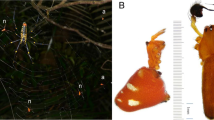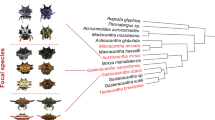Abstract
Recent studies have provided evidence that spiders’ color and pattern may attract prey items to their webs, thus increasing their foraging success. However, these studies were conducted on tropical spiders, and no studies have examined this phenomenon in temperate spiders. We examined the role of color and pattern in a North American spiny orb-weaver, Micrathena gracilis. We found that prey capture rates were similar between webs that contain spiders and webs in which spiders were removed. Additionally, we found a trend that painted spiders captured more prey than unpainted spiders. Although our results were not statistically significant, they contradict previous studies examining the role of color in prey attraction.


Similar content being viewed by others
References
Andrews K, Reed SM, Masta SE (2007) Spiders fluoresce variably across many taxa. Biol Lett 3:265–267
Bjorkman-Chiswell BT, Kulinski MM, Muscat RL, Nguyen KA, Norton BA, Symonds MRE, Westhorpe GE, Elgar MA (2004) Web-building spiders attract prey by storing decaying matter. Naturwissenschaften 91:245–248
Blackledge TA (1998) Signal conflict in spider webs driven by predators and prey. Proc R Soc Lond BBiol Sci 265:1991–1996
Blackledge TA, Wenzel JW (1999) Do stabilimenta in orb webs attract prey or defend spiders? Behav Ecol 10:372–376
Bukowski TC, Christenson TE (1997) Natural history and copulatory behavior of the spiny orb weaving spider Micrathena gracilis (Araneae, Araneidae). J Arachnol 25:307–320
Bukowski TC, Christenson TE (2000) Determinants of mating frequency in the spiny orb weaving spider, Micrathena gracilis (Araneae: Araneidae). J Insect Behav 13:331–352
Craig CL (1991) Physical constraints on group foraging and social evolution: observations on web-spinning spiders. Funct Ecol 5:649–654
Craig CL, Bernard GD (1990) Insect attraction to ultraviolet-reflecting spider webs and web decorations. Ecology 71:616–623
Craig CL, Ebert K (1994) Color and pattern in predator-prey interactions: the bright body colors and patterns of a tropical orb spinning spider attract flower-seeking prey. Funct Ecol 8:616–620
Eberhard WG (2007) Stabilimenta of Philoponella vicina (Araneae: Uloboridae) and Gasteracantha cancriformis (Araneae: Araneidae): Evidence against a prey attractant function. Biotropica 39:216–220
Hauber ME (2002) Conspicuous coloration attracts prey to a stationary predator. Ecological Entomol 27:686–691
Haynes KF, Gemeno C, Yeargan KV, Millar JG, Johnson KM (2002) Aggressive chemical mimicry of moth pheromones by a bolas spider: how does this specialist predator attract more than one species of prey? Chemoecology 12:99–105
Heiling AM, Herberstein ME, Chittka L (2003) Pollinator attraction: crab-spiders manipulate flower signals. Nature 421:334–334
Herberstein ME, Craig CL, Coddington JA, Elgar MA (2000) The functional significance of silk decorations of orb-web spiders: a critical review of the empirical evidence. Biol Rev 75:649–669
Hoese FJ, Law EAJ, Rao D, Herberstein ME (2006) Distinctive yellow bands on a sit-and-wait predator: prey attractant or camouflage? Behaviour 143:763–781
Levi HW (1978) The American orb weaver genera Colphepeira, Micrathena and Gasteracantha north of Mexico (Araneae; Araneidae). Bull Mus Comp Zool 148:417–442
Levi HW (1985) The spiny orb-weaver genera Micrathena and Chaetacis Araneae Araneidae. Bull Mus Comp Zool 150:429–618
Oxford GS, Gillespie RG (1998) Evolution and ecology of spider coloration. Annu Rev Entomol 43:619–643
SAS Institute (2002) SAS system version 9.1 for Windows. SAS Institute, Cary
Stowe MK, Tumlinson JH, Heath RR (1987) Chemical mimicry: bolas spiders emit components of moth prey species sex-pheromones. Science 236:964–967
Tso IM, Tai PL, Ku TH, Kuo CH, Yang EC (2002) Color-associated foraging success and population genetic structure in a sit-and-wait predator Nephila maculata (Araneae: Tetragnathidae). Anim Behav 63:175–182
Tso IM, Lin CW, Yang EC (2004) Colorful orb-weaving spiders, Nephila pilipes, through a bee’s eyes. J Exp Biol 207:2631–2637
Tso IM, Liao CP, Huang RP, Yang EC (2006) Function of being colorful in web spiders: attracting prey or camouflaging oneself? Behav Ecol 17:606–613
Uetz GW, Biere JM (1980) Prey of Micrathena gracilis (Walckenaer) (Araneae: Araneidae) in comparison with artificial webs and other trapping devices. Bull Br Arachnol Soc 5:101–107
Uetz GW, Hartsock SP (1987) Prey selection in an orb-weaving spider Micrathena gracilis (Araneae, Araneidae). Psyche (Cambridge) 94:103–116
Vaclav R, Prokop P (2006) Does the appearance of orb weaving spiders attract prey? Annales Zoologici Fennici 43:65–71
Acknowledgements
We thank Perri K. Eason, Lina B. Rifai, and Tom C. Pelletier for providing helpful comments and advice. We also thank the Horner Endowment Fund for partial support of this study. Apo M. Teldy also provided support throughout the preparation of this manuscript.
Author information
Authors and Affiliations
Corresponding author
Rights and permissions
About this article
Cite this article
Vanderhoff, E.N., Byers, C.J. & Hanna, C.J. Do the Color and Pattern of Micrathena gracilis (Araneae: Araneidae) Attract Prey? Examination of the Prey Attraction Hypothesis and Crypsis. J Insect Behav 21, 469–475 (2008). https://doi.org/10.1007/s10905-008-9142-3
Revised:
Accepted:
Published:
Issue Date:
DOI: https://doi.org/10.1007/s10905-008-9142-3




